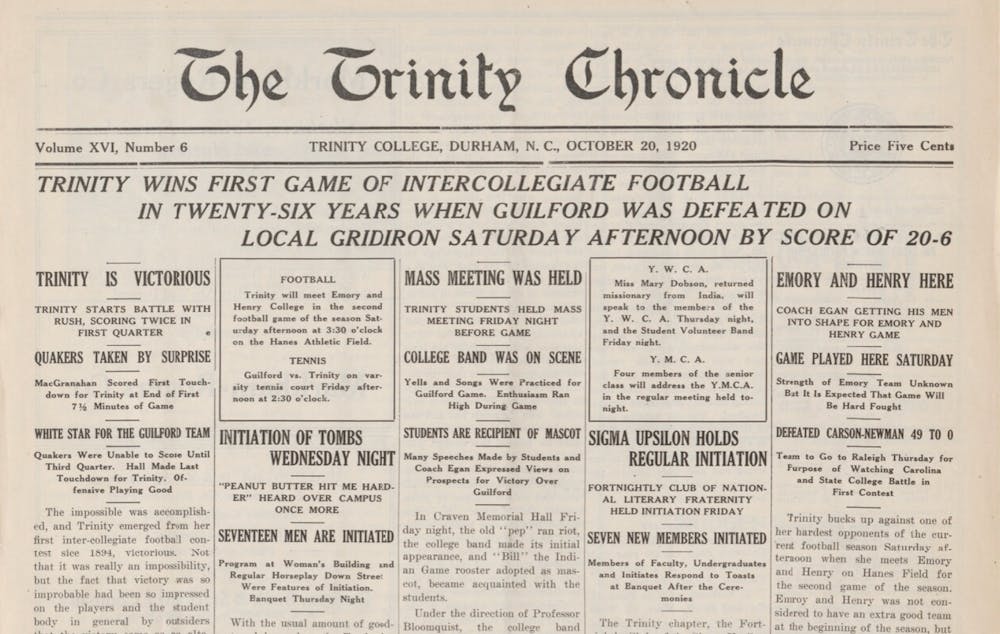In honor of Duke’s Centennial, the Blue Zone’s Blast from the Past series highlights pivotal figures and events in Duke sports history. Next, we look at the 1920 return of Trinity’s football team:
It had been 26 years since the last Trinity football team geared up, leaving the excitement of intercollegiate games in the past, until now. On Oct. 16, 1920, Coach Floyd Egan’s squad prepared for a hard-fought victory against Guilford as Trinity football alumni and fans alike anxiously gathered to watch. To them, this game was the beginning of a hopeful season and the long-awaited revival of an irreplaceable college tradition.
In the early 1890s, fear about the safety of college football brewed. Among those hesitant were many Methodist Church leaders — a previously strong force of influence on Trinity College’s academic and athletic affairs. Both the president of Trinity and the coach of the first football team, John Crowell, knew the college experience wasn’t complete without football. Complaints flooded his office, but he always backed athletics and physical activity at Trinity. However, following his resignation, a much more reluctant President John Kilgo decided that America’s game was simply too dangerous and immoral to play. The decision was final — in December 1894, intercollegiate football was banned at Trinity College.
Fans of the game pushed back year after year and fought for its return until President William Few excitedly reinstated football in 1918. The thrill of college football was finally brought back to the field. With Trinity football back in action, all eyes were on this untested yet promising team and its historic matchup against Guilford.
The adrenaline rush, what-ifs and second-guessing all came to a head as Trinity’s first kick-off commenced. Trinity’s defense held strong as Guilford’s initial rush attempts were halted, failing to put up any points on the board. Trinity took possession at its own 30-yard line, and, although the offense took an uneasy start, a few breaks in Guilford’s line and quick end runs by Trinity’s men powered the ball down the field. It was only a matter of a few yards until Trinity would score its first touchdown in 26 years. With only seven minutes chipped off the play clock, Trinity’s Fred McGranahan managed to surge through the opponent line and score.
The Trinity team went into the half with a 14-0 lead on Guilford, but both teams suffered a scoring drought in the second and third quarters. Still scoreless and time running low, Guilford took advantage of the offsides penalties the inexperienced Trinity men racked up. It was Trinity’s mistakes that moved the ball into scoring territory, but it was Guilford’s strength that hoisted the ball over the line.
The Chronicle had a couple takes on Trinity’s players, saying that “although they had the fundamentals of the game as taught them by Coach Egan,” they were taking “a long step from playing against member’s of one’s own squad.” The Chronicle’s post-game recap also highlighted team successes and star players, stating that “all the men made brilliant plays at stages of the game, but no one was better than the other.” Trinity’s talent all over the field — an undeniable quality of the current Blue Devil team — propelled it to a 20-6 victory. Trinity football was back to stay.
The win not only reinvigorated students, but gave the team the confidence to carry momentum into each game throughout its season. According to The Chronicle, Trinity clinched such a surprising victory that “the impossible was accomplished.” And so every future matchup became a chance for fans to rally for this historic Trinity team.
Today, weekends at Duke are undoubtedly incomplete without students decked out in blue and white flooding the stands of Wallace Wade Stadium. Fans singing along to “All I Do Is Win” and waving Blue Devil-decorated towels seems like second nature. To this Trinity team, though, the excitement of football was new, and it craved more.
The team's 1920 victory against Guilford built the foundation for what would quickly become an undeniable part of Trinity’s — and later Duke’s — athletic identity. One hundred and four years later, the roar of football remains at the heart of school spirit at Duke. Today the Blue Devils take the field with the same grit and energy that fueled a much-anticipated Trinity triumph, upholding a legacy that continues throughout every game and every season.
Get The Chronicle straight to your inbox
Sign up for our weekly newsletter. Cancel at any time.

